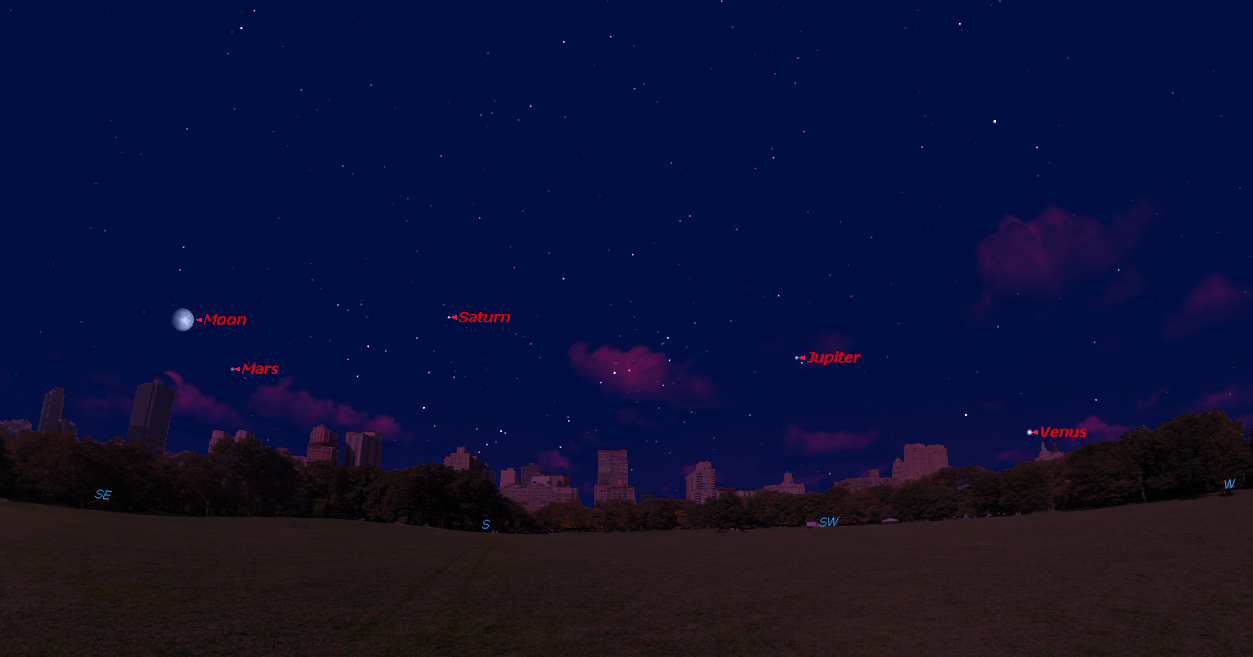Planetary Bonanza Tonight: See All the Planets in One Night

Why settle for a planet or two when you can catch all of them in just one night of intense skywatching?
Tonight (Aug. 23) and for a brief period in early September, that feat is surprisingly doable for people living in midnorthern latitudes like the U.S. All you need is a little planning and cooperative weather. And you don't even need to sacrifice a whole night's sleep.
"You can see the majority of the sky on any night of the year if you stay up all night long, so only having to stay up half the night is kind of a treat," Irene Pease, vice president of the Amateur Astronomers Association of New York, told Space.com. "It's cool to be able to say that you've seen all of the planets, but then to have the street cred to be able to say, 'Oh, I saw them all in one night,' is just a kind of neat bucket-list thing." [The Brightest Planets in the August Night Sky (and How to See Them)]
First, pick a date. While the planets are aligning well through early September, the brightness of the full moon, which peaks on Aug. 26, will make skywatching on the surrounding nights more challenging. Sky and Telescope recommends trying to catch the planets before Aug. 24 or between Aug. 30 and Sept. 9.
For Pease, Mercury is always the hardest planet to spot because it is so close to the sun. "The trick to Mercury is getting out there before the sun sets and making sure you have a really clear view of the horizon," Pease said. "Just being able to see that in the glare of the sunset can be kind of tricky."
But after that, it gets easier. Next come the four particularly bright planets: Venus, Jupiter, Saturn and Mars. These four will line up with Venus low in the western sky, Jupiter to the southwest, Saturn to the south and Mars to the southeast.
"You can get all of those in within an hour of a sunset," Pease said. "Then, I would take a break, maybe celebrate, and then come back."
Get the Space.com Newsletter
Breaking space news, the latest updates on rocket launches, skywatching events and more!
The final stops on your whirlwind planet tour will be Uranus and Neptune, for which you'll want to arm yourself with at least binoculars or, ideally, a small telescope. Both planets are far enough away that they might be tricky to distinguish from stars. According to Sky & Telescope, they'll be easiest to catch just before midnight in the constellations Pisces and Aquarius respectively.
As usual, you'll want to find someplace with relatively dark skies and keep an eye on the weather forecast to avoid cloudy conditions. "Bring a buddy, because it's more fun, and bring bug repellent if you're one of those people bugs love to eat," Pease said. She also recommended using a skywatching app like SkySafari that can help you tailor your observations to your location or looking up a detailed star map to help you find the more distant planets Uranus and Neptune.
Just don't get so caught up in catching the wandering stars that you forget to look down at the Earth holding you up to round out your total planetary haul of the solar system.
Editor's note: If you have an amazing skywatching photo you'd like to share for a possible story or image gallery, please contact managing editor Tariq Malik at spacephotos@space.com.
Email Meghan Bartels at mbartels@space.com or follow her @meghanbartels. Follow us @Spacedotcom, Facebook and Google+. Original article on Space.com.
Join our Space Forums to keep talking space on the latest missions, night sky and more! And if you have a news tip, correction or comment, let us know at: community@space.com.

Meghan is a senior writer at Space.com and has more than five years' experience as a science journalist based in New York City. She joined Space.com in July 2018, with previous writing published in outlets including Newsweek and Audubon. Meghan earned an MA in science journalism from New York University and a BA in classics from Georgetown University, and in her free time she enjoys reading and visiting museums. Follow her on Twitter at @meghanbartels.









